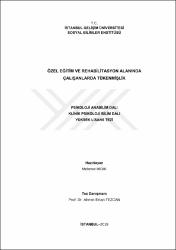| dc.contributor.author | Mıdık, Mehmet | |
| dc.date.accessioned | 2020-02-09T19:12:01Z | |
| dc.date.available | 2020-02-09T19:12:01Z | |
| dc.date.issued | 2019 | en_US |
| dc.date.submitted | 2019-06-28 | |
| dc.identifier.uri | https://hdl.handle.net/11363/1963 | |
| dc.description | Danışman: PROF. DR. AHMET ERTAN TEZCAN
Yer Bilgisi: İstanbul Gelişim Üniversitesi / Sosyal Bilimler Enstitüsü / Psikoloji Anabilim Dalı / Klinik Psikoloji Bilim Dalı
Konu: Psikoloji = Psychology
Dizin: Tükenmişlik = Burnout ; Tükenmişlik duygusu = Burnout feeling ; Tükenmişlik düzeyi = Burnout level ; Tükenmişlik sendromu = Burnout syndrome | en_US |
| dc.description.abstract | Çalışanların işyerinde yorulması ya da yıpranması anlamına gelen duygusal tükenme, tükenmişliğin en çok yaşanan boyutudur ve çalışanın kendini duygusal olarak yıpranmış ve yorulmuş hissindeki artış olarak tarif edilir. Duygusal tükenme, yoğun çalışma temposundaki kişinin aşırı sorumluluk alarak zorlanması ve hizmet götürdüklerinin beklentileri karşısında yetersizlik yaşaması sonucu ortaya çıkar. Tükenmişliğin ikinci boyutu, kendisini diğerlerine alaycı ya da olumsuz tutum sergileme veonlara bir madde muamelesi yapma şeklinde gösteren duyarsızlaşmadır. Çalışan içinde bulunduğu duygu durumla baş edebilmek için, hizmet götürdüklerine karşı alaycı, onları küçümseyen, duyarsız davranış bütünü göstermektedir. Böyle bir duygu durumunda kişinin kendisi ile ilgili değerlendirmeleri olumsuz bir nitelik kazanır. Bu durum onun iş ve iş arkadaşlarıyla ilişkisinde yetersizlik duygusu yaşamasına yol açar. Kişisel başarı beklentisindeki düşme sonucunda, tükenmişliğin üçüncü boyutu ortaya çıkmış olur. Özel eğitim alanı, hizmet verilenle birebir ilişkinin yoğun olduğu bir alandır. Aile, engelli ya da uzmanın beklentisinin bazen yüksek olduğu bilinmektedir. Çalışmamızda tükenmişlik genel bir anlatım ile özetlenmiş ve özel eğitim kurumlarında çalışanların yaşamış oldukları tükenmişliğin gizli, örtük fenomenleri açıklanmaya çalışılmıştır. Çalışmamızın birinci bölümünde, tükenmişlik olgusu ele alınmıştır. Tükenmişlik modelleri özetlenmiştir.Çalışma çerçevesinde ayrıca, tükenmişliğin nedenleri, tükenmişliğin fiziksel, davranışsal ve psikolojik nedenleri ele alındıktan sonra tükenmişliğin kişisel boyutu, iş hayatı üzerindeki etkileri vb. gibi sonuçlar ele alınmıştır. Çalışmamızın ikinci bölümünde ise; özel eğitim ve rehabilitasyon kurumlarında çalışanların tükenmişlik düzeylerini belirlemek için bir alan araştırması yapılmıştır. Yapılan bu araştırmada; bireylerin duyarsızlaşmasının, onların duygusal tükenmişlik düzeyini olumlu etkilediği bulunmuş ve tükenmişliğin en kritik boyutunun duygusal tükenme boyutu olduğu sonucu elde edilmiştir. | en_US |
| dc.description.abstract | Emotional exhaustion, which means tired or worn out at the workplace, is the most experienced dimension of burnout and can be described as an increase in the emotionally worn and tired feeling of the employee. Emotional exhaustion can be defined as an increase in fatigue and emotional corrosion of the employee. Emotional exhaustion is the result of self-coercion of the individual in the intense work environment and the oppression of the emotional demands of other people. The second dimension of burnout is depersonalization which approves itself as mocking and negative attitudes towards others and having attitudes as if they were objects. The employee shows the whole of cynical, rigid and distant behavior in order to cope with the emotional situation. The individual's evaluations of oneself become negative in such an emotional case. This situation leads the individual to feel inadequate in relationship with his work and colleagues. As a result of fall in the expectation of personal success, the third dimension of burnout is revealed. The field of special education is a field where one-to-one relationship with the ones who are given the service is intense. It is known that the expectation of family, disabled or expert is sometimes high. In the study, burnout was summarized with a general narrative and the hidden, implicit phenomena of the burnout experienced by the employees of private educational institutions was tried to be explained. In the first part of the study, the phenomenon of burnout is discussed. The burnout models are summarized. Additionally, after the causes of burnout, the physical, behavioral and psychological causes of burnout are discussed, the personal dimension of burnout, the effects on business life etc. are discussed. In the second part of the study, a study of field was conducted to determine the burnout levels of employees in special education and rehabilitation institutions. In this study, it was concluded that the depersonalization of individuals positively affects their level of emotional exhaustion. It was founded that emotional exhaustion is the most critical aspect of burnout. | en_US |
| dc.language.iso | tur | en_US |
| dc.publisher | İstanbul Gelişim Üniversitesi Sosyal Bilimler Enstitüsü | en_US |
| dc.rights | info:eu-repo/semantics/openAccess | en_US |
| dc.rights | Attribution-NonCommercial-NoDerivs 3.0 United States | * |
| dc.rights.uri | http://creativecommons.org/licenses/by-nc-nd/3.0/us/ | * |
| dc.subject | Tükenmişlik | en_US |
| dc.subject | Duygusal Tükenme | en_US |
| dc.subject | Kişisel başarı | en_US |
| dc.subject | Duyarsızlaşma | en_US |
| dc.subject | Stres | en_US |
| dc.subject | Kararsızlık | en_US |
| dc.subject | Burnout | en_US |
| dc.subject | Emotional Exhaustion | en_US |
| dc.subject | Personal Success | en_US |
| dc.subject | Depersonalization | en_US |
| dc.subject | Stress | en_US |
| dc.subject | Indecision | en_US |
| dc.title | Özel eğitim ve rehabilitasyon alanında çalışanlarda tükenmişlik | en_US |
| dc.title.alternative | Burnout in workers in special education and rehabilitation | en_US |
| dc.type | masterThesis | en_US |
| dc.department | Sosyal Bilimler Enstitüsü | en_US |
| dc.relation.publicationcategory | Tez | en_US |



















